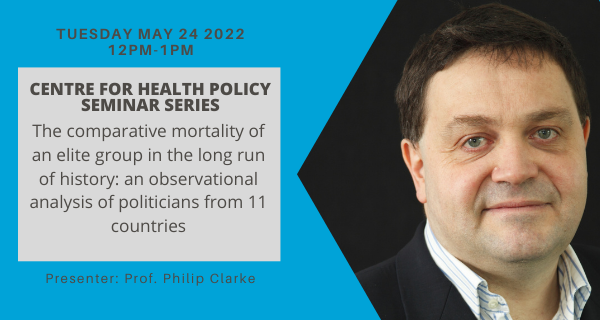CHP Seminar - Prof Philip Clarke

The comparative mortality of an elite group in the long run of history: an observational analysis of politicians from 11 countries
Presenter: Prof Philip Clarke (University of Oxford/Centre for Health Policy, University of Melbourne)
Date and Time: Tuesday May 24 2022 12noon-1pm (AEST)
Join on your computer or mobile app
Click here to join the meeting
If prompted for a password, please enter: 717636
Philip has recently compared the mortality rate and life expectancy of politicians with those of the age and gender-matched general populations. This was an observational analysis of mortality rates of politicians (i.e. members of national parliaments with available data on dates of birth, death and election, gender, and life tables) in 11 developed countries. Politicians were followed from their election date until either death or the last available year with life table data. Relative mortality differences were estimated using standardised mortality ratios (SMRs). The study included 57,561 politicians (with follow-up ranging from 1816–2016 for France to 1949–2017 for Germany). In almost all countries politicians had similar rates of mortality to the general population in the early part of the 20th century. Relative mortality and survival differences (favouring politicians) increased considerably over the course of the 20th century, with recent SMRs ranging from 0.45 (95%CI 0.41–0.50) in Italy to 0.82 (95%CI 0.69 to 0.95) in New Zealand. The peak life expectancy gaps ranged from 4.4 (95% CI, 3.5–5.4) years in the Netherlands to 7.8 (95% CI, 7.2–8.4) years in the US. These results show large relative and absolute inequalities favouring politicians in every country. In some countries, such as the US, relative inequalities are at the greatest level in over 150 years.